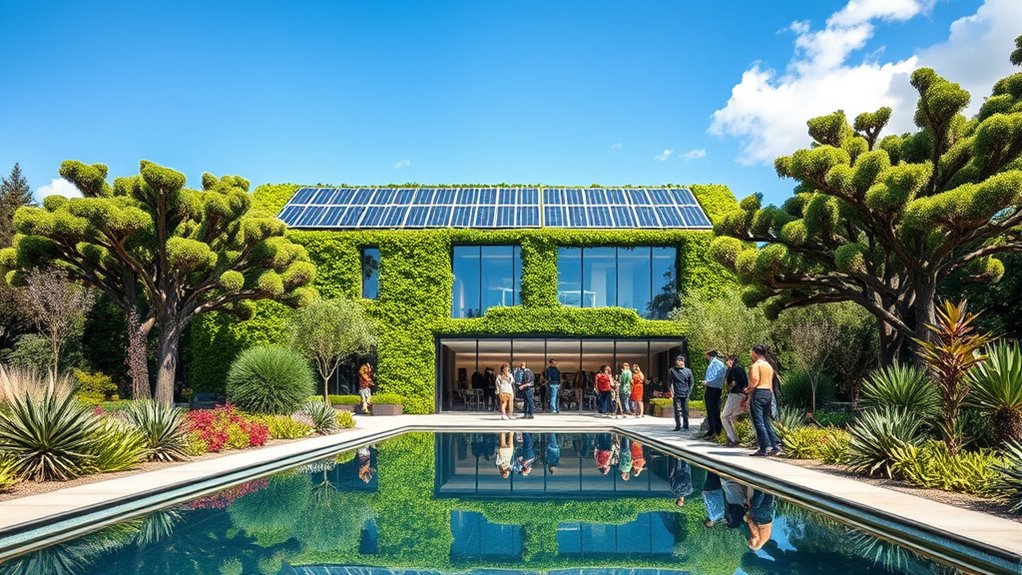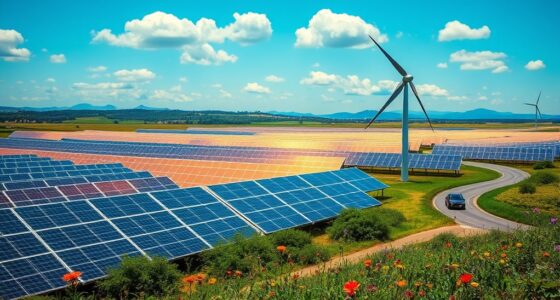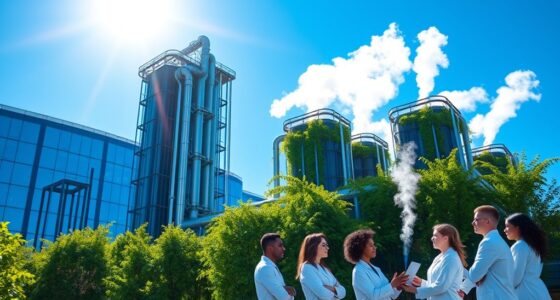If you're looking for top sustainable architecture firms, you should check out Miller Hull Partnership, Lake Flato, BNIM, Perkins + Will, and Payette. Each firm excels in environmentally responsible design and innovative building practices, focusing on energy efficiency and community engagement. You'll see how they utilize sustainable materials and cutting-edge technologies in their projects. Want to discover even more about these leaders in sustainable architecture? There's plenty more to uncover!
Key Takeaways
- Miller Hull Partnership: Founded in 1977, focuses on sustainable architecture with notable LEED Platinum projects and community engagement.
- Lake Flato: Established in 1984, recognized for high-performance buildings and regionalism, receiving accolades for its diverse sustainable portfolio.
- BNIM: Known for innovative designs with a commitment to net-zero energy by 2030, achieving multiple LEED and Living Building certifications.
- Perkins + Will: A leader in sustainable architecture, emphasizes renewable resources and transparency through comprehensive ESG reports on projects like the Rush University Medical Center.
- Payette: Specializes in healthcare and museums, aiming for at least LEED Silver certification while incorporating energy-saving features and smart systems.
Miller Hull Partnership
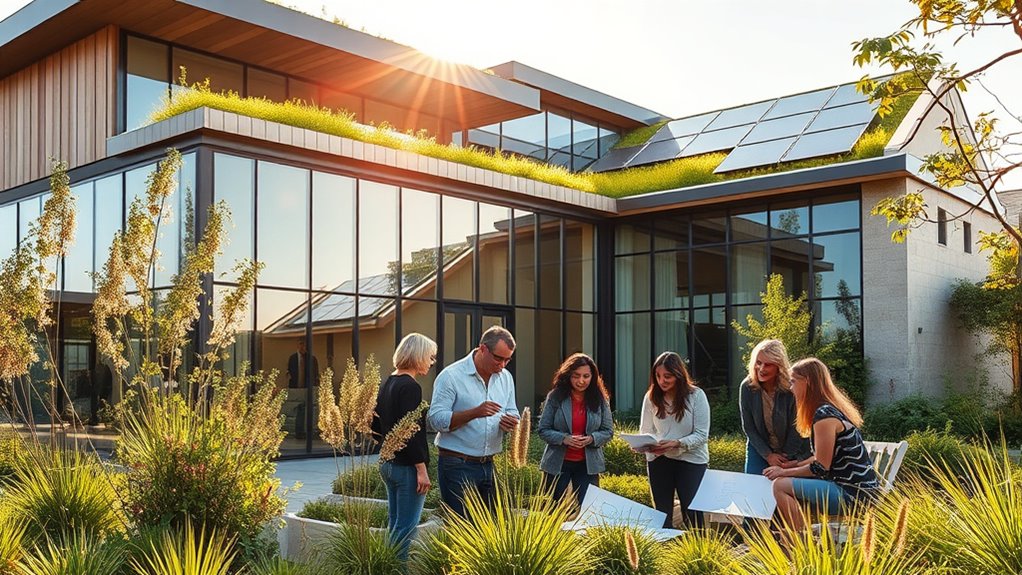
Miller Hull Partnership stands out as a leader in sustainable architecture, founded in 1977 and rooted in Seattle and San Diego.
You'll appreciate their innovative approach to architecture, urban, and interior design, focusing on environmentally responsible solutions. They design projects like the Bullitt Center, striving for self-sufficiency, and the LOTT Clean Water Alliance Regional Services Center, which achieved LEED Platinum certification. Their projects often integrate heat pump technology, enhancing energy efficiency and indoor air quality. Additionally, they leverage AI technologies to optimize building performance and reduce energy consumption.
Their commitment to sustainability shines through in projects such as the Whidbey Island Retreat and the Del Mar Civic Center, which use natural materials and sustainable energy systems. Additionally, their designs often incorporate solar energy solutions, enhancing energy efficiency and reducing reliance on traditional power sources. This focus on eco-friendly minimalism reflects a growing awareness of the importance of sustainable living practices.
With over 350 awards, Miller Hull emphasizes community engagement and environmental stewardship, ensuring their designs align with the latest sustainability standards while promoting equity and resilience. This dedication reflects a broader trend towards environmental innovations that seek to enhance resource efficiency and reduce ecological footprints.
Lake Flato

Since its founding in 1984, Lake Flato has established itself as a pioneering force in sustainable architecture, based in San Antonio with an additional office in Austin.
Recognized by *Architect* magazine as the top architecture firm in 2019, it's the first Texas firm to earn this honor.
You'll appreciate their diverse portfolio, featuring projects like the Witte Museum and Confluence Park. Lake Flato emphasizes sustainability by creating high-performance buildings that minimize energy use and carbon impact. Their designs often incorporate natural materials like wood and stone, which are fundamental in modern farmhouse style, to enhance both aesthetics and environmental responsibility. Their approach is akin to AI in Marketing, where data is leveraged to optimize results. Additionally, their commitment to using renewable resources supports sustainable harvesting practices. They prioritize sustainable practices that align with eco-friendly building standards and reduce long-term environmental impacts.
Their commitment to material efficiency and restorative environments has led to numerous LEED certifications.
With a focus on regionalism and adaptive reuse, they continue to innovate by transforming sites while preserving cultural and ecological integrity. Additionally, their designs often incorporate biodiversity hotspots to enhance local ecosystems and support wildlife.
BNIM
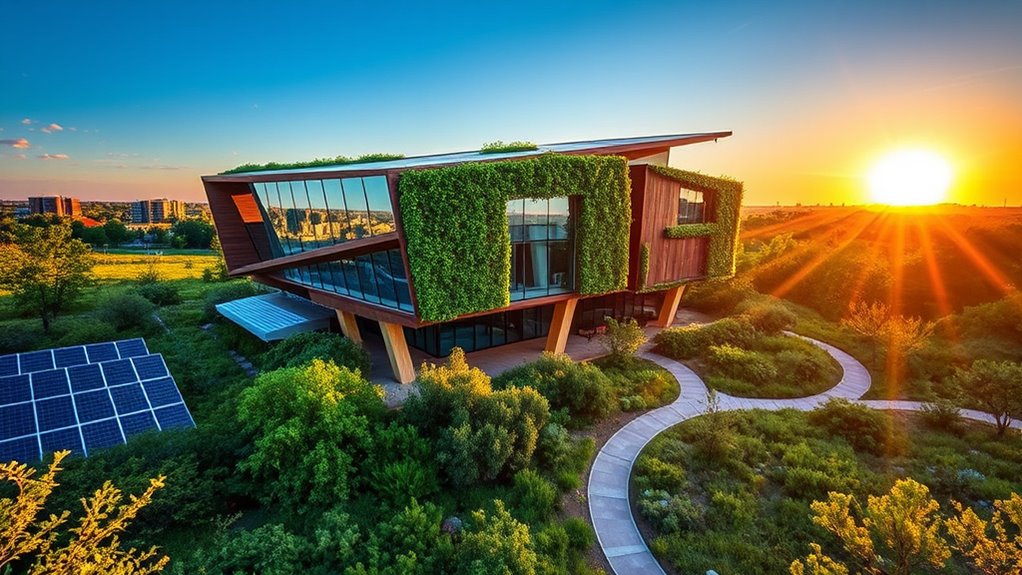
BNIM stands out as a leader in sustainable architecture, renowned for its innovative designs and commitment to high-performance buildings. You're likely to appreciate their Building Positive prototype in Kansas City, which exemplifies mixed-use sustainability. Their projects demonstrate how HEPA filtration can greatly improve indoor air quality in commercial spaces. Creating spaces that are both functional and comfortable is essential for families and seniors, highlighting the importance of wellness design principles. Additionally, their commitment to hydrogen fuel cells as a clean energy source underscores their dedication to reducing environmental impacts.
Their Omega Center for Sustainable Living boasts both LEED Platinum and Living Building certifications, highlighting their dedication to high standards. BNIM's projects focus on community engagement, incorporating green spaces that enhance public amenities. They effectively use natural light, renewable energy systems, and bio-climatic principles to reduce energy consumption. Additionally, their designs often integrate energy-efficient heat pumps, which significantly lower operational costs and contribute to sustainability goals. Furthermore, these energy-efficient systems have the potential to reduce energy bills by up to 50%, further supporting their commitment to sustainability.
With goals of achieving net-zero energy by 2030 and net-positive carbon emissions by 2050, BNIM is committed to sustainable coexistence with nature. Their collaborative approach ensures projects align with sustainability goals, making a lasting impact.
Perkins + Will

As one of the leading firms in sustainable architecture, Perkins + Will embodies a strong commitment to environmentally responsible design.
You'll find that they prioritize sustainable materials, utilizing renewable resources to minimize environmental impact. Their impressive portfolio includes award-winning projects like the Rush University Medical Center and the Shanghai Natural History Museum, both certified LEED Gold. Additionally, many of their projects incorporate renewable energy sources, such as heat pumps, to enhance energy efficiency and reduce carbon footprints. Furthermore, they emphasize the use of sustainable sourcing practices to ensure the materials they select contribute positively to the environment.
With over 20 global offices, Perkins + Will actively contributes to sustainable practices worldwide. They're recognized for their transparency through comprehensive ESG reports, showcasing their dedication to environmental, social, and governance metrics. Additionally, their projects often incorporate low-carb vegetables to promote healthier living environments.
Payette

Payette stands out in the realm of sustainable architecture, particularly known for its innovative designs in healthcare facilities, laboratories, and museums.
You'll appreciate their multidisciplinary approach, which connects architecture, planning, and landscape design to create cohesive, sustainable environments. With a commitment to minimizing environmental impact, Payette aims for at least LEED Silver certification in its projects. Their designs often incorporate energy-saving features that reduce overall energy consumption significantly. Regular maintenance can enhance the efficiency of the refrigeration cycle in heat pump technology, contributing to overall energy savings. Additionally, implementing smart systems in their designs can further improve energy management and efficiency. Their energy reduction strategies and integrated design charrettes foster collaboration to achieve optimal outcomes. Notable projects like the Gary C. Comer Geochemistry Building showcase their expertise in energy efficiency and cutting-edge materials. Furthermore, their commitment to strategic planning ensures that all factors, including potential tax implications of operational costs, are considered to maximize sustainability. Additionally, they incorporate heat pump technology to enhance energy efficiency and reduce operational costs in their designs.
ZeroEnergy Design
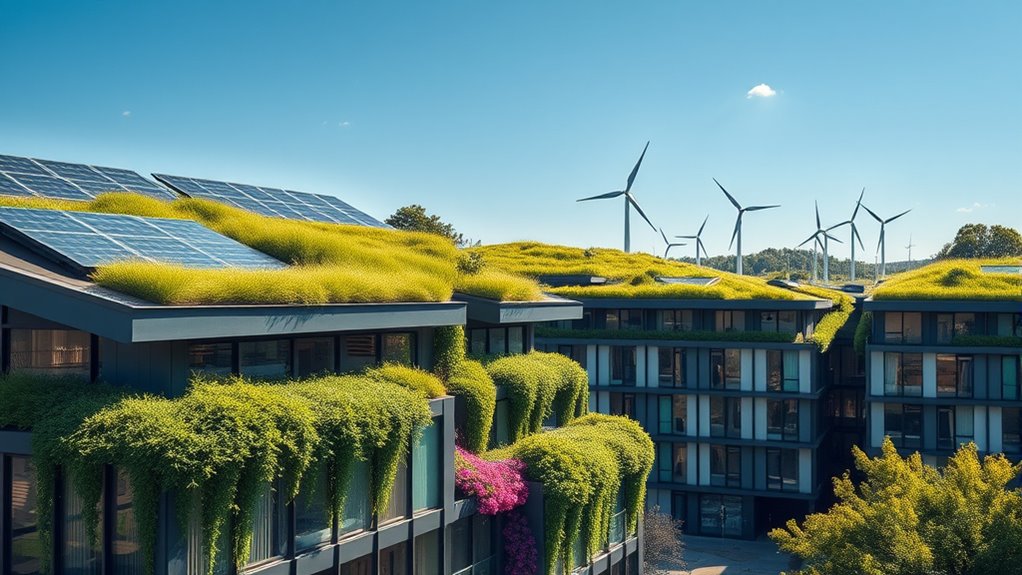
When you explore the innovative world of ZeroEnergy Design, you'll discover a firm dedicated to creating high-performance sustainable buildings that exceed conventional energy standards.
Their approach combines architecture, mechanical design, and financial analysis to achieve remarkable energy efficiency. By designing to the Passive House standard, they create net-zero energy buildings that rely on renewable sources. Additionally, they often utilize HEPA filters in their designs to enhance indoor air quality, contributing to healthier living environments. Moreover, their projects are informed by predictive modeling, which helps ensure that energy needs are accurately anticipated and met. Furthermore, the integration of renewable energy technologies is expected to significantly increase efficiency in their designs. This commitment to innovation mirrors the concept of AI advancements, which also strives for improved efficiency and effectiveness in various sectors.
Combining architecture, mechanical design, and financial analysis, they achieve exceptional energy efficiency with Passive House net-zero energy buildings.
Inspired by the surrounding landscape, their unique designs reflect a holistic methodology that incorporates client values and environmental concerns. With a commitment to using sustainable materials and minimizing environmental footprints, ZeroEnergy Design not only prioritizes energy independence but also promotes healthy living environments. Additionally, their projects often emphasize color accuracy to enhance the overall aesthetic and comfort of the spaces they create.
Recognized as a leader in Boston, they continuously push boundaries to set new standards in sustainable architecture.
Andrew Sidford Architects

Founded in 1992, Andrew Sidford Architects brings over 30 years of architectural expertise to the forefront of sustainable design. Based in Newburyport, the firm excels in historic renovations and contemporary projects, ranging from single-family homes to large commercial ventures.
As the first architectural firm to join 1% For the Planet in 2006, they prioritize LEED building practices and sustainable materials. Their philosophy emphasizes that good design is inherently sustainable, focusing on minimizing environmental impact while ensuring human comfort. In addition, they understand the importance of integrating IRAs with local investment opportunities for long-term financial stability.
With a dedicated team, including multi-disciplinary designer Cindy Schartman and experienced Senior Designer Joel Kline, Andrew Sidford Architects creates unique designs that harmonize with their surroundings, earning recognition in esteemed publications like Boston Globe Magazine. Additionally, their approach aligns with protecting retirement income strategies that prioritize long-term stability and comfort in various contexts.
Frequently Asked Questions
What Defines Sustainable Architecture in Modern Design Practices?
Sustainable architecture in modern design practices focuses on minimizing environmental impact while maximizing efficiency and comfort.
You'll see energy-efficient designs that harness natural light and utilize renewable materials like bamboo. Water conservation technologies, such as rainwater harvesting, play a crucial role too.
Additionally, buildings are adaptable for longevity, ensuring they meet future needs. By integrating smart technologies and biophilic elements, you create spaces that connect people with nature and foster healthier environments.
How Can Homeowners Incorporate Sustainable Practices in Renovations?
You can turn your home into a superhero of sustainability! Start by conducting an energy audit to uncover hidden inefficiencies.
Use renewable materials like bamboo and reclaimed wood for renovations. Install energy-efficient windows and appliances that save you money while protecting the planet.
Don't forget to repurpose materials instead of tossing them! By prioritizing these practices, you'll not only create a beautiful space but also become an eco-friendly champion in your community.
What Are the Costs Associated With Sustainable Building Materials?
When considering sustainable building materials, you'll notice higher upfront costs compared to traditional options. Prices vary based on material type and location, with treated bamboo and engineered wood being prime examples.
However, these materials can lead to significant long-term savings through energy efficiency and durability. Plus, they contribute to environmental benefits, such as reduced carbon emissions.
Ultimately, weighing initial costs against lifecycle savings can help you make a financially sound choice.
How Do Sustainable Buildings Impact Property Values?
You know what they say: "You get what you pay for."
Sustainable buildings enhance property values by attracting eco-conscious tenants willing to pay a premium. Energy-efficient features reduce operational costs, while green certifications boost marketability.
With lower maintenance needs and increased resilience against climate risks, these properties become more desirable.
Ultimately, investing in sustainability not only saves money in the long run but also elevates your property's worth in a competitive market.
What Certifications Should I Look for in Sustainable Architecture?
When you're exploring sustainable architecture, look for certifications like LEED, BREEAM, and the WELL Building Standard.
These certifications ensure that a project meets rigorous environmental and health criteria. You should also consider Passive House and Net Zero Carbon Building Standards, which emphasize energy efficiency and carbon neutrality.
Having these certifications not only signifies a commitment to sustainability but can also enhance the building's value and appeal to environmentally-conscious clients.
Conclusion
In the world of sustainable architecture, these firms stand like beacons, guiding us toward a greener future. They blend innovation with nature, crafting spaces that breathe and inspire. By choosing to work with these trailblazers, you're not just building structures; you're nurturing a legacy of environmental stewardship. So, let your vision soar and embrace the beauty of sustainable design—every brick laid is a step toward harmony between humanity and our planet. Together, let's build a better tomorrow!
